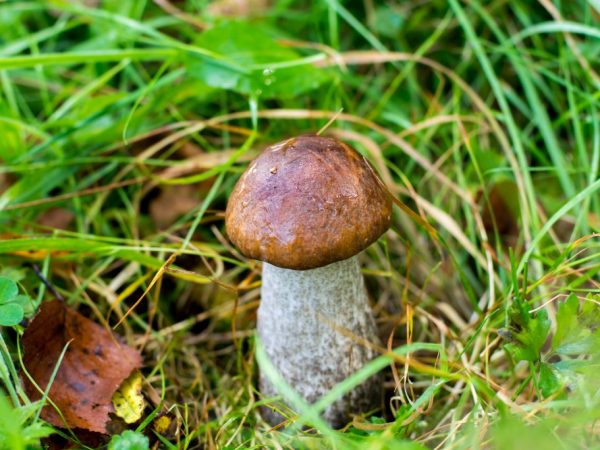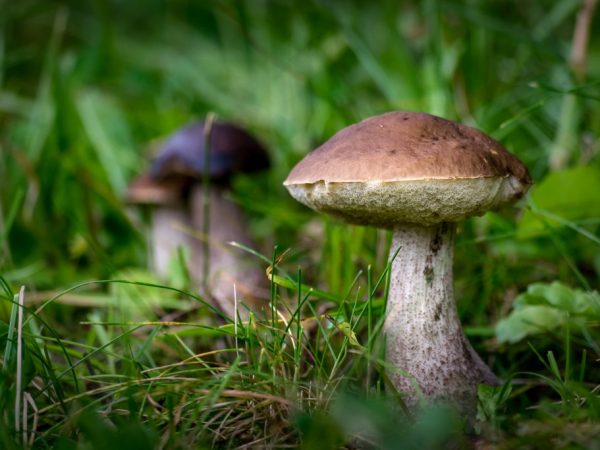Mushroom hornbeam
The hornbeam mushroom, which tastes good, is used in many areas. It has similar characteristics to the common boletus, but differs in a more brownish hat. They appreciate it for its abundant fruiting and useful qualities. It is heavily damaged by larvae.

Mushroom hornbeam
Description
Gray boletus (gray boletus, elm boletus) belongs to the Boletovye order and the family of the same name. Grows in deciduous forests of Eurasia, America. Forms mycorrhiza with hornbeam, sometimes with poplar, birch, hazel. Prefers bright places. Harvested from June to October.
Grabovik is an edible mushroom. It is similar to other boletus mushrooms and the inedible gall mushroom. To distinguish gray obabok from other species, you should study its description.
Hat:
- up to 14 cm in diameter;
- hemispherical in young specimens, cushion-shaped in more mature specimens;
- wrinkled, velvety;
- edges slightly tucked up in young specimens;
- matte in dry weather and shiny in wet weather;
- brown-gray color of different shades, less often light ocher, whitish;
- sometimes in old mushrooms, the cuticle of the cap shrinks, as a result of which the pulp and tubules located along the edge of the cap become noticeable.
Leg:
- up to 13 cm in height, up to 4 cm in diameter;
- thickened at the bottom;
- the top is olive gray, the bottom is brown;
- scales at first whitish, after a while - dark brown.
Pulp:
- white, when cut becomes pinkish-purple, over time - dark gray, almost black;
- soft;
- fibrous stem;
- tough in mature mushrooms.
Tubular layer:
- up to 3 cm in thickness;
- free;
- soft;
- with a recess near the leg;
- slightly watery;
- white or sandy gray.
Spores are spindle-shaped. The spore sac is brown.
The grabovik is an edible mushroom, it differs from the boletus boletus in that the color of the flesh at the end of the present does not change color. At the same time, the hornbeam is less valuable in terms of taste, because
The pulp of his cap is inferior in density to the pulp of boletus boletus. If you confuse a hornbeam with other types of boletus boletus, it's not scary, because they are all edible mushrooms. But if you send a gall mushroom to the basket, then everything is much worse. These mushrooms are very similar in appearance. Although the gall mushroom is non-poisonous, it has a very bitter taste, which makes the mushroom inedible. You can distinguish mushrooms only by carefully examining the leg - in the gall fungus, it is covered with a characteristic mesh, and not with scales, like in a hornbeam.
By the way. Very often mushroom pickers bypass the hornbeam, because take it for a "spoiled" boletus because of the peculiarities of the external structure of the cap - wrinkling.
Useful properties and contraindications

The mushroom is suitable for dietary nutrition
Gray obabok is a low-calorie product and is suitable for dietary nutrition. Contains vitamins B, E, C, PP, as well as minerals and other components:
- protein;
- leucine;
- tyrosine;
- glutamine.
Boletus is a heavy food for digestion in the digestive tract. In rare cases, a person may develop an individual intolerance.It is worth trying in small quantities. It is contraindicated in children and people with stomach and duodenal ulcers.
Application
Mushrooms of this type are classified in category 2 for nutritional value. The taste is good.
In cooking
The gray grab is stewed, fried, boiled, pickled, salted and dried. It retains its qualities when frozen.
It should be cooked no later than 12 hours after the harvest is harvested. If there is moss on the mushrooms, it is enough to rinse them and clean them of debris, especially the base of the leg. Fruit bodies that grew on sandy soil must be scraped off with a knife and rinsed several times in clean water. After cutting, inspect the pulp for the presence of pests. Damaged places are cut out, wormy specimens are thrown away. In older organisms, the tubular layer is removed. It is left only in case of pickling and salting.
Mushrooms require careful heat treatment. They are boiled two times:
- first to remove debris and pests;
- then in clean, salted water until cooked for about 20 minutes.
In this form, they are suitable for storage in the refrigerator for 2 days. Otherwise, put in the freezer. Do not freeze raw.
In medicine
Grabovik is used for medicinal purposes. It has a positive effect on the body:
- has a beneficial effect on the nervous system;
- regulates blood sugar (glucose);
- improves kidney function;
- promotes the introduction of toxins from the body.
Growing
The cultivation process is similar to the cultivation of porcini mushrooms. But the yield of gray boletus is distinguished by the best indicators. The optimal time for sowing is from May to the end of August.
Process steps:
- Prepare the site, remove the garbage.
- Around the birch, holes are dug under the "seeds" 20 cm deep and 10 cm in diameter. The tree must be at least 4 years old, otherwise the beginning of fruiting will be delayed.
- The holes are filled with a mixture of soil and peat.
- Lay a piece of compost mycelium and cover it with earth.
- Ramp down.
To increase fruiting, you should properly care for the mycelium. In the dry season, it is necessary to ensure soil moisture by sprinkling. To do this, use a spray bottle. Water the garden in the afternoon so that direct sunlight does not fall on it. Low herbaceous plants are often planted nearby. They do not interfere with the penetration of light, but they can create protection from the sun.
Top dressing can increase yields. Funds are bought in a specialized store. Apply according to the instructions. With the onset of cold weather, the site is covered with straw, spruce branches, fallen leaves, moss. When it gets warm, the protection is removed.
Mushrooms appear in the first year of cultivation. From 5 to 15 fruit bodies grow around the tree. The highest fruiting occurs 2 years after planting. After 5 years, the amount of the crop decreases.
Conclusion
Grabovik has high taste and health benefits. When collecting it, it is worth considering that it is poorly stored and requires urgent processing. Fibrous pulp cleanses the intestines of toxins.
Boletus is also grown at home. The quality and quantity of fruiting bodies is directly related to the care of the mycelium.



